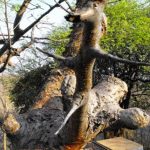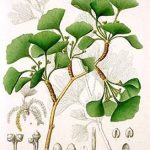TREE LIFE
April 2015
MASHONALAND CALENDAR
Saturday April 4th (NOTE CHANGE OF DAY AND TIME): Botanic Gardens Walk with Tom Muller: Meet at 9.00am in the car park of the Harare Botanic Gardens. This walk will last for 1hr 30mins.
Sunday 19th April – Barwick School courtesy of Dave and Wendy Dolphin. We hope to visit some interesting riverine forest near the Dyke.
Saturday 25th April – Visit to Christon Bank
It has been a while since we last visited Christon Bank; it’s an interesting area botanically with plenty to see. We will meet at 1430hours.
Saturday 25th April – Sat 2nd May: Visit to CATAPÚ – PLEASE NOTE CHANGE – there is now no longer a second group. Those of you who have booked please confirm your booking with Meg by email – megcp@zol.co.zw – and also confirm that you have made a deposit of $100 per person into the CABS account number: 1002549477, Account name: W .R. Clarke Tree Society. Your name must be reflected as a reference, and also please advise the Treasurer (wrc@mweb.co.zw) by email of the date of your deposit.
Notice of the Annual General Meeting of the Tree Society
Notice is hereby given that the 65th Annual General Meeting of the Tree Society of Zimbabwe will be held at the Education Centre, Mukuvisi Woodlands on Sunday 10th May 2012 at 9.30 am.
Any proposals/resolutions and nominations for office bearers (and any volunteers to be on the Committee) should be forwarded to the Secretary Teig Howson at teig.howson@gmail.com by Sunday 3rd May if possible, although proposals and nominations will be accepted from the floor.
AGENDA
- Notice convening the meeting.
- Apologies.
- Minutes of the 64th A.G.M.
- Matters Arising.
- Chairman’s Report.
- Treasurer’s Report.
- Election of Committee Members.
- Proposed amendments to the Constitution
- Any Other Business.
TREE SOCIETY MEMBERSHIP
Membership for 2015 was due on April 1st. If you would like to vote at the AGM on 10th May please pay your $10 to Bill Clarke or Mark Hyde either before or at the meeting.
PLEASE HELP: We are looking for the contact details of Colin Taylor (phone numbers or email address). His email address insingisi@zol.co.zw is not working. Please contact Tony Alegria if you have an alternative.
Also: a pair of sunglasses was left at Linda Bromley’s house after the last Tree Society outing to Monavale Vlei. If they are yours or you know to whom they belong, please contact Dorothy on piumosso@zol.co.zw.
– Ed
TREE OF THE MONTH
Anthocleista grandiflora
Common names: Forest big-leaf; Zezuru: Mugopogopo; Ndau: Gururu, Muyama.
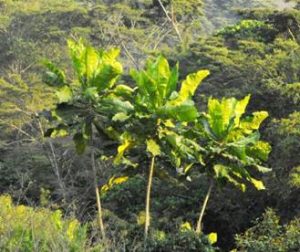
Anthocleista grandiflora
This Eastern Highlands tree is from the Family Gentianacea that comprises 87 genera, totalling 1,600 species worldwide. In Zimbabwe the family is represented mostly by two flowering plants found in damp ground (Chironia purpurascens and C. palustris) and one tree – A. grandiflora. Within southern Africa there is only one other tree of that family: A. liebrechtsiana growing in the Zambezi valley around Katima Mulilo in Namibia.
You will all know the antiseptic dye Gentian Violet. That name was originally used for a mixture of methyl pararosaniline dyes (methyl violet) but is now often considered a synonym for crystal violet. The name only refers to its colour, being like that of the petals of a gentian flower, the dye is not made from gentians or from violets.
On the other hand the roots of an herbaceous Gentianaceae, the European Yellow Gentian Gentiana lutea, have been used for thousands of years as an appetite stimulant, as the major ingredient in Angostura Bitters, as a medicine for digestion problems, and it is also used to bring down fever.
The family Gentianaceae takes its name from the genus Gentiana, named after the Illyrian king Gentius (Illyria was a region in classical antiquity in what is today the Western Balkans). Anthocleista is derived from the Greek anthos, meaning flower and cleistos meaning closed or shut-up. In Zimbabwe A. grandiflora occurs naturally in the Inyanga and Vumba regions.
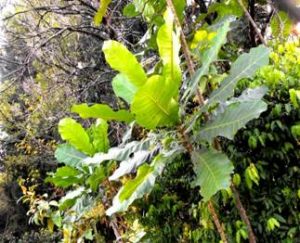
Anthocleista grandiflora leaves
The bark is brown to dark brown, smooth with prominent scars of the fallen leaves. The branching occurs at the top so that the trunk is always clean and tall. The very large leaves (sometimes up to 150cm x 50 cm), are clustered at the end of the branches and at first glance they are reminiscent of Strelitziaceae.
The flowers are creamy-white and quite striking. They grow in large terminal clusters that have a sweet jasmine scent.
The fruit is a 30 mm long fleshy egg-shaped green berry, soft and yellow when mature. It contains many small dark seeds.
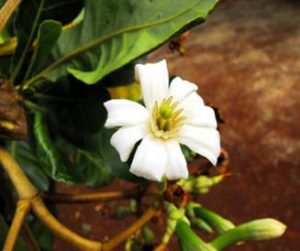
Anthocleista grandiflora flower
The wood is whitish-yellow, light, soft and easy to work. It does take a nice polish but is very brittle and prone to termite attacks. It can only be used for short lived items such as firewood, crates or boxes.
Gelfand et al. (1985) mention that inhaling the smoke from the bark drives away bad spirits. It is also reputed to be good against epilepsy. In other countries a tea is made from leaves to treat malaria; bark is chewed to treat diarrhoea, diabetes and high blood pressure. It is always a source of surprise to me that when a plant is deemed to be good against a particular ailment it soon develops into a panacea.
It is a beautiful tree to plant in a typical suburban garden so long as it does not get too cold, too windy and gets sufficient water.
Sources:
Coates Palgrave, K. 1977. Trees of Southern Africa . Struik, Cape Town.
Gelfand, M., Mavi, S., Drummond, R.B. and Ndemera, B. 1985. The Traditional Medical Practitioner in ZImbabwe. Mambo Press, Harare.
Goldsmith, B. and Carter, D.T. 1992. The Indigenous Timbers of Zimbabwe. Forestry Commission, Harare.
Van Wyk, B. and Van Wyk, P. 1997. Field Guide to the Trees of Southern Africa . Struik, Cape Town.
Wikipedia: https://en.wikipedia.org/wiki/Gentius https://en.wikipedia.org/wiki/Crystal_violet
Photographs: JP Felu.
– J.P. Felu
VISIT TO CHIMANIMANI – continued
Thursday, 29 January to Monday 2 February 2015
DAY 3. 31 JANUARY 2015: RATHMORE ESTATE
One of the events not included in Bill’s meticulous plans for that wonderful trip to Chimanimani was that we would be held up by a tractor and trailer which had been overturned as a result of being driven by a very inebriated and garrulous driver. From the back of the convoy Mark and I were very happy that it was someone else’s problem and we happily got on with a bit of botanising along the side of the road. The obstacle was cleared and we were able to proceed to the planned rendezvous spot which was in a lovely forest on Rathmore Estate. This was the area Lady Plunkett had called her ‘garden’ and soon we discovered she had planted quite a lot of trees. Fortunately Tempe was in my group because the first one we encountered had me totally baffled. No wonder, it was a South African endemic, Greyia sutherlandii, known as a Beacon tree or Mountain or Natal bottlebrush. It is one of a small genus of three species and certainly something I would never have expected to see there. Others that I suspect had been planted were Dombeya rotundifolia, Wild-pear, a woodland species, Bauhinia tomentosa, Yellow Bauhinia, more at home along the Umvumvumvu River at 800m than in a forest at 1500m above sea level.
Embelia schimperi, River dotted-leaf, is really what I call an ‘honorary tree’ in that it tends to lean against other trees rather than stand by itself – when it is big enough, of course, as it is often quite shrubby with long trailing branches. But it does have a label! The leaves are quite thickly textured with tiny translucent streaks that can be seen when it is held up against the light. The use of some sort of magnification does help to see this feature.
There was lots of Piper capense, Wild pepper. Piper nigrum is the species from which the culinary pepper comes (all three – black, white and green) and to obtain the different forms of the spice the berries are just treated differently. For black pepper, the berry is picked when not quite ripe and then dried until it shrivels and the skin turns dark brown to black; for white pepper the berries are allowed to ripen and the skin removed before they are dried; and green peppercorns are simply picked green and usually preserved in brine. This is a very interesting plant which looks as though it has opposite leaves with the flowers growing on the petiole, but flowers never grow on leaves, although they sometimes look as though they do. Very often opposite a leaf there is a branchlet with a leaf on the end of it looking for all the world as though it is another leaf and it is on this branchlet that there is sometimes a spike of tiny flowers, often bisexual with a few male flowers near the base.
The name ‘schimper’ came up again. This time it was Albizia schimperiana, Forest longpod, which was a surprise to me as I have always associated it with Mutare at a drier lower altitude. There is also the big one just outside the Herbarium in Harare. And of course there was the usual ‘how do you spell that’ and ‘what does it mean’? And I had to confess that I had no idea who Schimper was. He/she was not anyone I had ever looked up. Thank goodness for the internet, and I came up with four possibilities but in the end it could only be Georg Wilhelm Schimper. A German botanist and naturalist born 19 August 1804, who spent time botanising in North Africa, settled in Ethiopia in 1836 where he died in October 1878. In Zimbabwe there are 17 species named schimperi and seven species named schimperiana. This means if these species were named after Wilhelm Schimper they were probably named from specimens collected by him in Ethiopia and I checked on about half a dozen and that assumption was correct. It seems amazing that so many of our plants are so widespread.
In the understory was what I think was Dracaena fragrans, Small dragon tree, which is also very widespread throughout tropical Africa including Ethiopia. Mark though it was Dracaena steudneri, Large-leaved dragon tree because it was branching. One description I found said: ‘Young plants have a single unbranched stem with a rosette of leaves until the growing tip flowers or is damaged, after which it branches, producing two or more new stems; thereafter, branching increases with subsequent flowering episodes.’ I have one in my garden which I brought from Gorongosa Mountain and that has produced a sucker at the base as those in the Rathmore forest were doing. I also think that Dracaena steudneri is really more of a forest edge tree and Dracaena fragrans is a forest understory shrub.
And then someone looked up into the canopy and wanted to know what ‘those trees with a very distinctive pattern of leaves’ were. A little detective work around the trunks produced some leaves to prove that they were Trema orientalis, Pigeon wood. The real thing this time and not like anything we had seen at Bridal Veil Falls the previous day and which I think were all Grewia. The leaves were quite elongated, the apex drawn into a long point but most important there were serrations all the way around the margin, right to the base. What was so interesting is that these were mature trees in a forest canopy. I have always thought of this as a pioneer tree.
Rawsonia lucida, Forest peach, was a lovely surprise, perhaps because I have always seen it at a much lower altitude and here we were at 1500m. The leaves are very distinctive, quite stiff and leathery, the margin serrated with the teeth pointing forwards. As Tom would have said: ‘once seen never forgotten’! Just sometimes the name, like many names, is a bit elusive. This was apparently named after Sir R.W. Rawson who was Colonial Secretary to the Cape government, other details do not seem to be forthcoming other than this gentleman was born in 1812 and died in 1899 and the type specimen of Rawsonia lucida comes from Kwazulu Natal.
We eventually caught up with Mark, many of his group having passed us on their way back for lunch, and saw the grotto and the Ensete ventricosum, Wild Banana. Is this another honorary tree? Which begs the question what is a tree? If a tree is a big plant with a stick in the middle, then the banana, Musa, and the wild banana, Ensete, both in the same family Musaceae, shouldn’t be called ‘trees’ because they don’t have a ‘stick’ in the middle. So what constitutes a stick? Is it woody? The banana plant is a big plant with a thick stem and a whorl of leaves at the top but the stem is formed by the fibrous stalks of the leaves and rather like a cabbage stem is held rigid by the pressure of water in them, so botanically speaking it is a giant herb. But it is big and looks like a tree and behaves like a tree, although it is actually happier if there is some shade. It is more than 2 m high and we can sit in the shade of those huge leaves with that lovely reddish purple midrib, so I am happy to call it a tree.
In catching up with Mark we were able to discover the names of some of the plants I wasn’t able to name. The little climber we all agreed would look very attractive in a hanging basket is Behnia reticulata. This is related to Asparagus and one of its common names is Forest Smilax. The flowering Pavetta was not P. umtalensis as I had thought , because that was the only one on the list, but hairy Nyanga brides-bush Pavetta comostyla subsp. comostyla var. inyangensis ,to give it its full name, which has larger flowerheads. That woody climber that I thought might be Combretum paniculatum because the rather blunt hook-like thorns appeared to be persistent spiny petiole bases characteristic of the climbing Combretums, was actually Clerodendrum cephalanthum subsp. swynnertonii. The fact that those hooks appeared to be more or less in threes was interesting. This is another species that has snuck its way onto a tree list with the common name Rope tinder wood.
It was a lovely walk in a lovely forest and we all commented on the pleasure of just being in forest and enjoyed that as much as all the botanical interest. Thank you to John, Ann and Mary for helping me record what we saw and where we saw it on the three walks that I did. Thank you everyone for your interest and company and thank you to Bill for arranging what proved to be a hugely successful and enjoyable Tree Society trip.
– Meg Coates Palgrave
Day 4. Ist February 2015: the corner
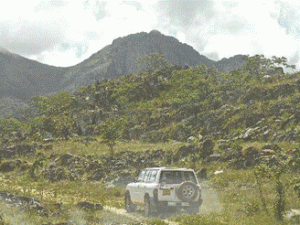
The Corner, Chimanimani
At the dinner at the Chimanimani Hotel on Saturday 31st January 2015 Doug van der Ruit asked for a show of hands by those wishing to go with him to The Corner on the following Sunday. Nine hands shot into the air. So 9 o’ clock the next day saw two vehicles (Doug’s and Zilla Batchelor’s) with five people in each heading out on the dirt road, mostly passable but pretty rough in spots, from Chimanimani village to The Corner, that beautiful piece of rugged country jutting into Mozambique behind the main Chimanimani mountain range. The predominant tree species there seems to be the mis-named Mountain Acacia, Brachystegia glaucescens / tamarindoides, but these are mostly dwarfs, more like large bonsais in appearance than the large trees normally seen in rocky outcrops. Of course there are other species there too, such as Tasselberries (Antidesma venosum I think), two species of Muzhanje (Uapaca kirkiana & zanzibarica), shiny green Newtonias,
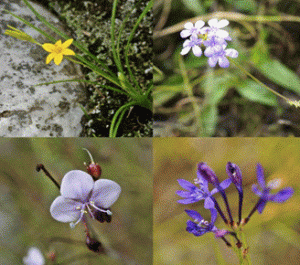
Hypoxis angustifolia, Buchnera chimanimaniensis, Murdannia simplex & Lapeirousia erythrantha.
Waterberries and others, as well as a multitude of small, pretty flowering plants like Lapeirousia erythranthe, Hypoxis angustifolia, Murdannia simplex, Xyris, the endemic Buchnera chimanimaniensis, some epiphytic orchids and even a few small Euphorbias, etc.
Possibly the most appealing feature of the area is the clear water of the Mahowa river which flows and tumbles through the ubiquitous rocks on its way into the neighbouring territory. Our group of ten made its way first to a pleasant pool below a small waterfall, then proceeded downstream for a kilometre or so until we reached the beautiful
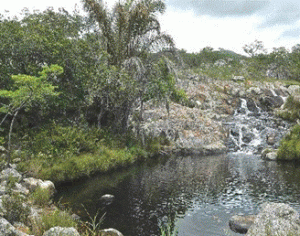
the beautiful Raphia Pool
Raphia Pool with its deep dark water at a perfect temperature for swimming, due perhaps to being fed by the waters of the river running widely over a long sloping rock-slide warmed by the sun. After an hour or more of swimming and basking or being massaged by the strong bubbling current entering the pool — a sort of natural jacuzzi — picnic lunch was enjoyed in the shade of the great Raphia Palms. How did they get there, one wondered? [Raphia Palm seeds used to be carried by Arab traders and often germinated near water – Ed].
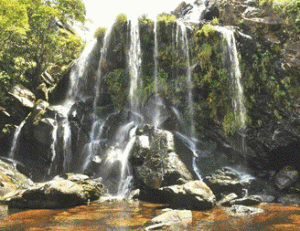
Mahohwa river
The return trek to the vehicles was by a different route, a little away from the river, so there were new things to be seen, including a small rock painting of an antelope which Doug showed us on a surprisingly exposed rock face. Light rain start to fall just as we reached the cars but this was by no means unpleasant as it had been quite hot at the lower altitude (around 1190 metres).
All in all the day had been a real joy and a great success.
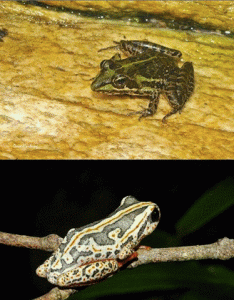
Common River Frog, Amietia quecketti, & Painted Reed Frog, Hyperolius swynnertonii/broadleyi
Two local residents: the Common River Frog, Amietia quecketti, & Painted Reed Frog, Hyperolius swynnertonii/broadleyi.
– Dave Hartung
Day 5: 2 February 2015
Return to Harare, so there was little to report on the botanical front.
Just before the ‘last supper’ on the previous day, I carried out a straw poll, asking random people what they had most enjoyed about the weekend and all but one said that it was the company and meeting old friends. It shows that the social aspect is a very important part of what the Tree Society is all about.
Everyone agreed that it had been an exceptionally enjoyable weekend. There were a number of trips, mishaps and falls but nothing serious. Plant specimens were collected and Meg and I will hopefully name these in due course.
Thanks must go to:
- Tempe and Doug van der Ruit for all their help both before and during the trip;
- my co-leader, Meg Coates Palgrave for her usual energy and knowledge and for preparing the lists of trees;
- various ‘scribes’: Anne Butler, Tempe, Dave Hartung, Meg Coates Palgrave and John Lawrence for writing up the days’ events;
- Richard for the quiz (“the easiest quiz I have ever set”);
- Dave Meikle at Outward Bound; and
- all the officials at the Chimanimani Hotel, National Parks and Rathmore Estate.
But above all I would like to give a special thank you to Bill. He made very detailed preparations for the weekend, including a special trip to Chimanimani in 2014 to inspect the accommodation, visit the various possible venues and arrange activities for each day. In particular, I would like to thank Bill for his meticulous, detailed planning; the welcoming sherry and pack of information, the daily seating plans, the precise timetables, the blue T-shaped stickers so that we could go straight through at the National Parks entrance and the list of things to bring (which included vacuum flask 3 times). Without Bill the weekend would not have been possible.
– Mark Hyde
MARK HYDE CHAIRMAN


